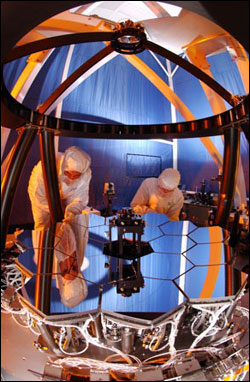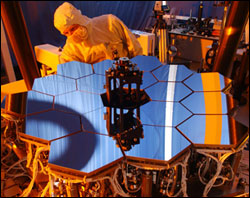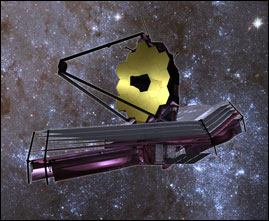
Telescope on SPIE Agenda
A set of algorithms and software programs have been designed to enable the 19 individual mirrors comprising NASA's powerful James Webb Space Telescope to function as one very sensitive telescope.
NASA researchers are presenting findings on these advances at Optic + Photonics, SPIE's annual meeting, being held this week at the San Diego Convention Center.

Image right: Engineers at Ball Aerospace test the wavefront sensing and vontrol testbed to ensure that the 18 primary mirror segments and one secondary mirror on JWST work as one. The test is performed on a 1/6 scale model of the JWST mirrors. Quicktime video: www.nasa.gov/mov/184907main_wavefront2.mov
(Photo: NASA/Northrop Grumman/Ball Aerospace)
After its launch in 2013, when the Webb Telescope settles into its vantage point about one million miles from Earth, and periodically thereafter, the orientations of the telescope’s 18 primary mirror segments and the position of the secondary mirror will have to be adjusted to bring light from the universe into focus. Through a process called wavefront sensing and control (WFSC), software on board the observatory will compute the optimum position of each of the 19 mirrors and then adjust the positions, if necessary.
The Webb Telescope's 18 primary mirror segments cover a combined total area of 25 square m (approx. 30 sq yd) and a diameter of 6.5 m (approx. 21 ft). "It's critical that all 18 mirror segments be aligned in position so that they act as one smooth surface, and the secondary mirror be placed exactly right," said Bill Hayden, Systems Engineer at NASA Goddard Space Flight Center, Greenbelt, Md. "This will allow scientists to clearly focus on very dim objects that we can't see now."

Through wavefront sensing and control, software aboard the observatory will compute the optimum position of each of the 18 primary mirrors and the one secondary mirror, and then adjust the positions, if necessary. Shown is a 1/6 model of the JWST mirrors that is used to test WFSC. (Photo: NASA/Northrop Grumman/Ball Aerospace)
The WFSC system is put to work when the telescope takes digital pictures of a star. It then processes the images through mathematical algorithms to calculate the mirror adjustments required to bring the stellar image into focus. When the individual mirrors are properly aligned, the Webb telescope will be able to obtain extraordinarily sharp images and detect the faint glimmer of a distant galaxy.
Recently, a team of engineers from Ball Aerospace & Technologies Corp., in Boulder, Colo., and NASA successfully tested the WFSC algorithms, proving they are ready to work on the Webb Telescope in space. The algorithms were tested on a detailed scale model of the 6.5-m space telescope and through computer simulations.
John Mather, senior project scientist on the Webb telescope at Goddard and the 2006 winner of the Nobel Prize in physics, said, "This major technological accomplishment, which built on the legacy of software algorithms used to fix the Hubble Space Telescope and align the Keck telescope, is a major step forward in the development of JWST. This achievement was the result of great teamwork between Ball Aerospace, NASA Goddard Space Flight Center and the Jet Propulsion Laboratory."

Artist's conception of JWST in space. Image: NASA
David L. Taylor, president and CEO of Ball Aerospace & Technologies Corp., said, "The same technological ingenuity Ball Aerospace applied to correcting the Hubble Space Telescope’s primary mirror in 1993 is being applied to advancing the optics for the JWST observatory."
Many of the presentations NASA will make at the meeting involve the Webb Telescope. JWST is a 21st-century space observatory that will peer back more than 13 billion years in time to understand the formation of galaxies, stars and planets and the evolution of our own solar system. It is expected to launch in 2013. The telescope is a joint project of NASA, the European Space Agency and the Canadian Space Agency.
Other JWST-related NASA presentations will cover mirror technology and their production at Tinsley Laboratories of Richmond, Calif. (Aug. 28, 8 a.m. and 8:20 a.m. (PDT 25A, paper 6671-1, conference 6671 and paper 6671-2, conference 6671)
A session on "Hunting Planets and Observing Disks with the JWST Nircam Coronagraph" will be held Aug. 29 from 11-11:20 a.m. (PDT in 29B, paper 6693-16 of conference 6693). Speakers will describe how the NIRCam instrument on JWST will be able to detect hot Jovian-mass companions orbiting young stars within 150 parsecs as well as "Jupiters" around the nearest, low-mass stars, how it will be used to study protostellar and debris disks, and how the NIRCam gives JWST significant advantages over large ground-based telescopes equipped with adaptive optics.
For more information, visit: spie.org/optics-photonics.xml
/Buyers_Guide/SPIE/c14069